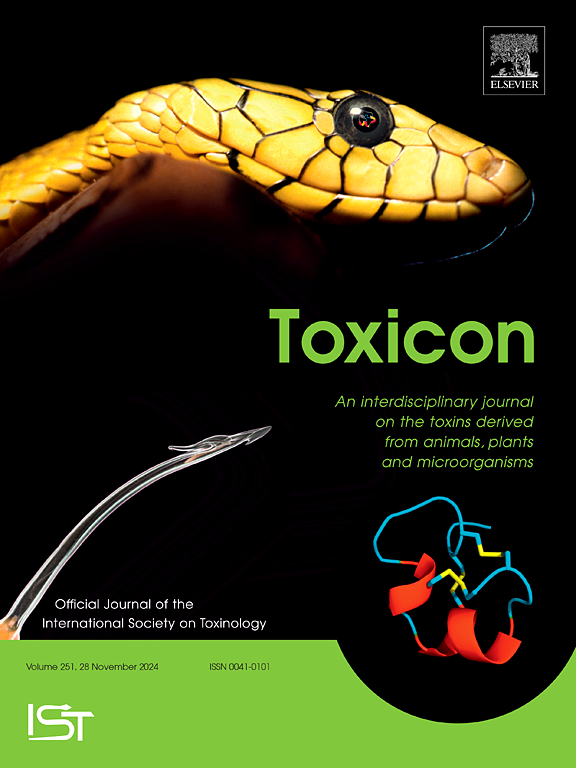Road Guarder (Conophis lineatus concolor: Dipsadidae): Case documentation of a clinically significant envenoming
IF 2.6
4区 医学
Q2 PHARMACOLOGY & PHARMACY
引用次数: 0
Abstract
Detailed cases of envenoming by a non-front-fanged snake (NFFS) from North, Central, and South America have had limited representation in the toxicology and toxinology literature. The NFFS, Conophis lineatus, has been reported to deliver bites that resulted in moderately severe envenoming. However, most of these reported cases have been via personal communication, or self-reported and lacking in detailed medical evaluations. Reported here is a case of an amateur naturalist who was traveling in Mexico and was envenomed following extensive protracted bites to both hands from a wild Conophis lineatus concolor. There was rapid development of extensive localized edema, intense pain, and ecchymoses. The patient was transported to a hospital and after arrival the administration of antivenom was considered due to the severe appearance of local symptoms. The patient requested the medical team contact a consultant toxinologist who advised against the administration of antivenom because of the absence of any supporting evidence demonstrating therapeutic benefit in treating envenoming by C. l. concolor. Consequently, all treatments were limited to supportive symptomatic care. Despite the development of prominent localized symptoms, all laboratory evaluations, including coagulopathy assessment values, revealed no remarkable abnormal alterations. The patient was discharged after two days and symptoms gradually resolved with two months of supportive care.

道路卫士(Conophis lineatus concolor: Dipsadidae):临床重大传染病的病例记录。
在毒理学和毒理学文献中,来自北美洲、中美洲和南美洲的非前牙蛇(NFFS)中毒的详细病例的代表性有限。据报道,NFFS, Conophis lineatus,会导致中度严重的环境。然而,这些报告的病例大多是通过个人沟通,或自我报告,缺乏详细的医疗评估。这里报告的是一个在墨西哥旅行的业余博物学家的案例,他的双手被一只野生的Conophis lineatus concolor长时间咬伤而中毒。迅速发展为广泛的局部水肿,剧烈疼痛和瘀斑。患者被送往医院,到达后由于出现严重的局部症状,考虑给予抗蛇毒血清治疗。患者要求医疗小组联系一名毒理学顾问,该顾问建议不要使用抗蛇毒血清,因为没有任何支持证据表明抗蛇毒血清对治疗c.l concolor中毒有治疗效果。因此,所有的治疗仅限于支持性症状治疗。尽管出现了突出的局部症状,但所有的实验室评估,包括凝血功能评估值,均未发现明显的异常改变。患者两天后出院,经过两个月的支持治疗,症状逐渐缓解。
本文章由计算机程序翻译,如有差异,请以英文原文为准。
求助全文
约1分钟内获得全文
求助全文
来源期刊

Toxicon
医学-毒理学
CiteScore
4.80
自引率
10.70%
发文量
358
审稿时长
68 days
期刊介绍:
Toxicon has an open access mirror Toxicon: X, sharing the same aims and scope, editorial team, submission system and rigorous peer review. An introductory offer Toxicon: X - full waiver of the Open Access fee.
Toxicon''s "aims and scope" are to publish:
-articles containing the results of original research on problems related to toxins derived from animals, plants and microorganisms
-papers on novel findings related to the chemical, pharmacological, toxicological, and immunological properties of natural toxins
-molecular biological studies of toxins and other genes from poisonous and venomous organisms that advance understanding of the role or function of toxins
-clinical observations on poisoning and envenoming where a new therapeutic principle has been proposed or a decidedly superior clinical result has been obtained.
-material on the use of toxins as tools in studying biological processes and material on subjects related to venom and antivenom problems.
-articles on the translational application of toxins, for example as drugs and insecticides
-epidemiological studies on envenoming or poisoning, so long as they highlight a previously unrecognised medical problem or provide insight into the prevention or medical treatment of envenoming or poisoning. Retrospective surveys of hospital records, especially those lacking species identification, will not be considered for publication. Properly designed prospective community-based surveys are strongly encouraged.
-articles describing well-known activities of venoms, such as antibacterial, anticancer, and analgesic activities of arachnid venoms, without any attempt to define the mechanism of action or purify the active component, will not be considered for publication in Toxicon.
-review articles on problems related to toxinology.
To encourage the exchange of ideas, sections of the journal may be devoted to Short Communications, Letters to the Editor and activities of the affiliated societies.
 求助内容:
求助内容: 应助结果提醒方式:
应助结果提醒方式:


